Warli Art is one of the most popular and famous folk arts in India. We can see Warli Art everywhere. In modern times, this art is being used in clothes, on sheets-pillows, on utensils, on decorative things, and on all kinds of objects or decorations in addition to traditional paintings.
Warli art, the most popular folk art of India, is the traditional art of the Warli tribe. Due to its simplicity, natural ingredients, easy techniques, and beautiful results, it is becoming increasingly popular among people. In fact, any child can make beautiful Warli pictures even with limited means.
(Read about Folk Art if you missed this Article)
So what is it that makes it so effective? Therefore, in response to this question, we discuss in detail Warli art on these points:
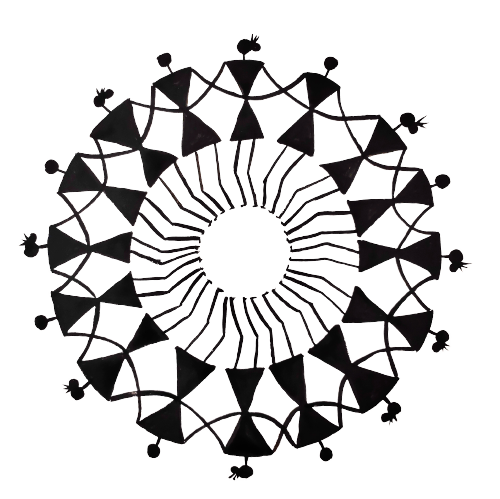
Warli Tribe
One of the old tribes Warli lives in India. This tribe lives in the coastal areas of the border of Maharashtra and Gujarat and the surrounding mountains.
This tribe has adopted its own Hindu beliefs and culture. These people speak a vernacular language that is related to the Indo-Aryan languages of the southern region. However, some people also consider this language as a dialect of the Marathi language.
So far as the word ‘Warli’ is concerned, it means a piece of land. These people would cultivate new land and then leave it and go out to find new land. According to oral beliefs, these tribes migrated to the foothills of the south in search of land for shifting cultivation. But the British found this tradition useless. So, they were evicted from the villages of dense forests and settled in the coastal areas.
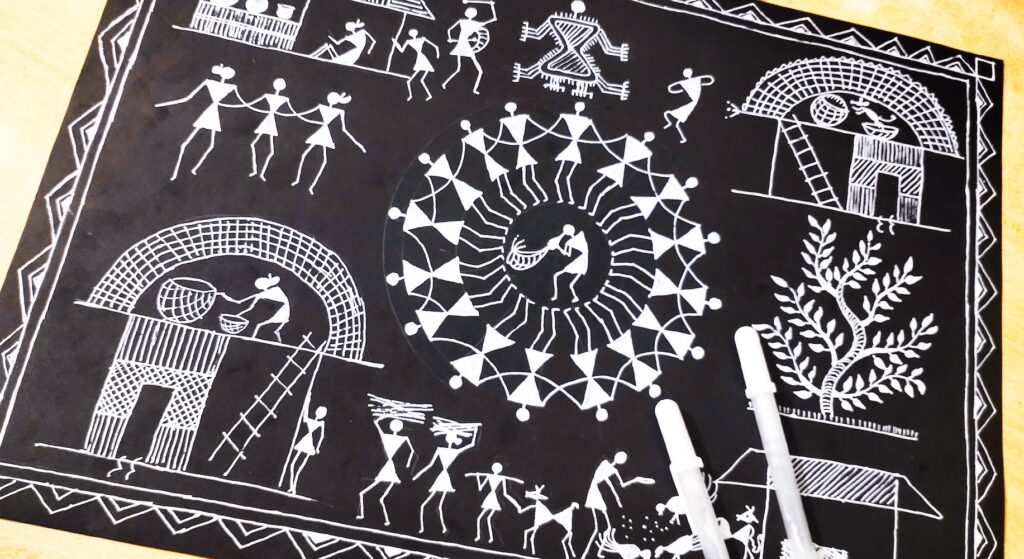
Paintings
The paintings of Warli are very ancient. Yashodhar Dalmiya, in his book “The Painted World of the Warlis”, claims about this art. He claims that the Warli tradition dates back to 2500 to 3000 BCE. The shell paintings were found at Bhimbetka in Madhya Pradesh. The dating back to 500-10000 BC is similar to Warli Painting. Until the 1970s, this art was dominated by women. Only women used to make these paintings. But now in modern times, everyone has started painting.
Characteristics of Painting
- Warli people have a strong attachment & importance to Mother Nature.
- However, all their customs and traditions are based on nature itself.
- Warli Artists use only some basic elements in traditional Warli paintings.
- These elements are circle, triangle, and square.
- Warli’s painting was inspired by nature. The circle represents the sun and the moon. However, the triangle is derived from the tip of mountains and trees.
- The use of the square may be a discovery of the Warli painters themselves. So, the square represents a piece of land.
- The square used in the middle of the pictures has special significance. These are called ‘Chauk’. It is of two types – Dev Chauk and Lagna Chauk.
- We can see Palghat Devi inside Dev Chauk. Palghat Devi is the symbol of fertility or the Goddess of Marriage.
- There is no practice of male deity in Warli paintings. They are often believed to be related to spirits who have assumed human form.
- The human and animal body is composed of two triangles. In this, the upper triangle represents the torso and the lower triangle represents the pelvis.
- Warli artists use the two triangles in these figures. In fact, it symbolizes the balance of the universe and the couples.
- The paintings depict scenes related to the lives of ordinary people. However, these scenes include hunting, fishing, and farming, festivals, and dances, and scenes of trees and animals.
Technique
- The technique of the Warli painting is very simple.
- A straight line is rarely seen in Warli’s paintings. While the series of dots forms a line in traditional folk art. But now in modern times, we can use the straight line.
- These paintings are made on the walls inside the huts and on the cloths.
- It is mainly a mural painting technique that is becoming prevalent nowadays. However, we paint it on all types of surfaces.
- The wall made of cow dung, mud, and branches provides the ocher red color surface (background) for the painting.
- Only white color is used in Warli’s paintings. Therefore, this white color is made by grinding rice and adding natural gum to it.
- A thin bamboo stick in the form of a paintbrush is softened by biting or chewing it with one end. So, this soft part is used as a paintbrush.
वार्ली कला
यह कला भारत में सबसे चर्चित व प्रसिद्ध लोक कलाओं में से एक है। वार्ली पेंटिंग को हम हर जगह देख सकते हैं। आधुनिक समय में इस कला का प्रयोग पारम्परिक चित्रों के अतिरिक्त कपड़ों में, चादर-तकिए पर, बर्तनों पर, सजावटी चीजों पर तथा सभी प्रकार की वस्तुओं या सजावट के समान पर किया जा रहा है।
भारत की सबसे चर्चित लोक कला वार्ली कला, वार्ली आदिवासियों की पारम्परिक कला है। अपनी सादगी, प्राकृतिक सामग्री, आसान तकनीक व सुंदर परिणाम की वजह से ये लगातार लोगों के बीच लोकप्रिय होती जा रही है। इस कला को कोई भी बच्चा सीमित साधनों के माध्यम से भी सुंदर वार्ली चित्र बना सकता है।
अतः ऐसा क्या है जो इसको इतना प्रभावी बनता है? इसी प्रश्न का उत्तर जानते हुए इसलिए वार्ली कला के विषय में विस्तार से चर्चा करते हैं।

वार्ली जनजाति
वार्ली आदिवासी भारत में पायी जाने वाली एक जनजाति हैं। यह जनजाति या आदिवासी महाराष्ट्र व गुजरात के सीमा के तटीय क्षेत्रों व आस-पास के पहाड़ों पर रहते है। इस जनजाति ने अपनी खुद की हिंदू मान्यताएँ व संस्कृति को अपनाया है। ये लोग एक अलखित भाषा बोलते हैं जो दक्षिणी क्षेत्र के भारतीय-आर्य भाषाओं से सम्बंधित है। कुछ लोग इस भाषा को मराठी भाषा की उपभाषा भी मानते हैं।
हम अगर वार्ली शब्द की बात करें, तो इसका मतलब भूमि के टुकड़े से होता है। ये लोग किसी भूमि पर खेती करते व उसके बाद उसे छोड़ के नयी ज़मीन खोजने निकल जाते। मौखिक मान्यताओं की मानें तो ये जनजाति खेती के स्थानांतरण के लिए भूमि की तलाश में दक्षिण की तलहटियों में चले गए। किंतु अंग्रेजों को ये परम्परा बेकार लगी। अतः उन्होंने इनके घने जंगलों के गावों से बेदख़ल कर तटीये क्षेत्रों में बसा दिया।
चित्र
वार्ली के चित्र बहुत प्राचीन माने जाते हैं। यशोधर डालमिया ने अपनी पुस्तक द पैंटेड वर्ल्ड ओफ़ द वारलीज़ में दावा किया है कि वार्ली परम्परा 2500 से 3000 ईसा पूर्व से चली आ रही है। मध्य प्रदेश के भीमबेटका में 500-10000 ईसा पूर्व के प्राप्त शेल चित्र, वार्ली के समान हैं। १९७० तक इस कला पर स्त्रियों का प्रभुत्व था। केवल स्त्रियाँ ही ये चित्र बनाया करतीं थी। किंतु अब आधुनिक समय में सभी चित्रकारी करने लगे हैं।
चित्रों की विशेषताएँ
- इस जनजाति के लोगों में प्राकृति का बड़ा महत्व है। उनके सभी रीति-रिवाज़ व परम्पराएँ प्राकृति पर ही आधारित हैं।
- प्राचीन वार्ली चित्रों में बहुत ही मूल तत्वों का प्रयोग हुआ है। ये तत्व वृत, त्रिकोण व वर्ग है।
- यह चित्रकला प्राकृति से प्रेरित है। वृत सूरज व चाँद का प्रतिनिधित्व करता है। त्रिकोण को पर्वतों व पेड़ों की नोक से लिया गया है।
- वर्ग का प्रयोग वार्ली चित्रकारों की खुद की खोज हो सकती है जो किसी भूमि के टुकड़े को दर्शाता है। चित्रों के मध्य में प्रयोग होने वाले वर्ग का विशेष महत्व होता है। इनको चौक या चौखट कहा जाता है। यह दो प्रकार के होते हैं-देव चौक व लग्न-चौक।
- देवचौक की बात करें तो इसके अंदर पालघाट देवी मिलतीं हैं। पालघाट देवी उर्वरता का प्रतीक मानी जातीं हैं।
- इन चित्रों में पुरुष देवता का चलन नहीं है। इनका सम्बन्ध अक्सर आत्माओं से माना जाता है जिन्होंने मानव रूप धारण कर लिया है।
- मानव व पशुओं के शरीर की रचना दो त्रिकोण से होती है। इसमें ऊपरी त्रिकोण धड़ को व निचला त्रिकोण पेडू को दिखता है।
- इन आकृतियों में प्रयुक्त दो त्रिकोण ब्रह्मांड व जोड़ों के संतुलन का प्रतीक है।
- चित्रों में सामान्य जन-जीवन से जुड़े द्रशयों का चित्रण किया जाता है। इन दृश्यों में शिकार, मछली पकड़ना और खेती करना, त्योहार और नृत्य, पेड़ और पशुओं के दृश्य शामिल हैं।
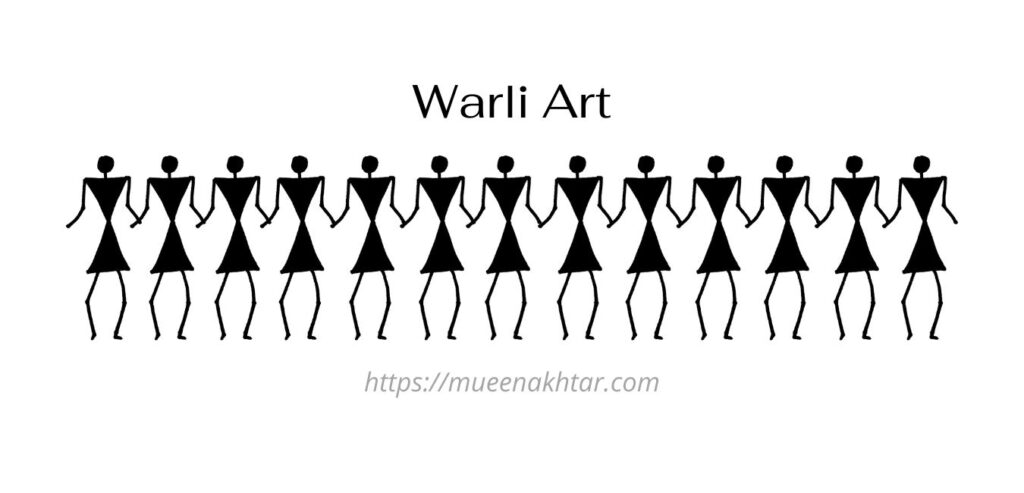
तकनीक
- वार्ली चित्र की तकनीक बहुत ही सादगी वाली है।
- इन चित्रों में सीधी लाइन बहुत ही कम देखने को मिलती है। बिंदुओं की ऋंखला एक रेखा बनाती है।
- किंतु अब आधुनिक समय में सीधी लाइन का भी प्रयोग किया जाने लगा है।
- यह चित्र झोपड़ियों के अंदर, दीवारों पर, व कपड़े पर बनाए जाते हैं।
- यह मुख्यतः भित्त चित्रण तकनीक है जो आजकल प्रचलित हो कर हर तरह के सतह पर की जा रही है।
- गाय के गोबर, मिट्टी व शाखाओं से बनी दिवार चित्रकारी के लिए गेरू लाल रंग की सतह (पृष्ठभूमि) प्रदान करती है।
- वार्ली चित्रों में केवल सफ़ेद रंग का उपयोग किया जाता है। यह सफ़ेद रंग चावल को पीस कर उसमें प्राकृतिक गोंद मिला कर बनाया जाता है।
- तूलिका के रूप में बांस की पतली छड़ को एक सिरे से कूट कर या चबाकर नरम किया जाता है। इसी नरम हिस्से को तूलिका के रूप में प्रयोग किया जाता है।
Latest Posts
- Claude Monet क्लोड मोने | प्रभाववादी चित्रकार Impressionist Artist
- Practice Set of Impressionism Art | प्रभाववाद की कला
- Impressionism Art (प्रभाववाद की कला): History, Features, & Artists
- Role of Art Teacher | Art Teacher in KVS
- गुस्ताव कुर्वे (Gustave Courbet) | Artist of Realism Art
- Honore Daumier | आनॉर दोमिये | Artist of Realism Art


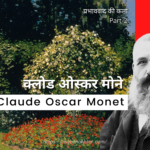
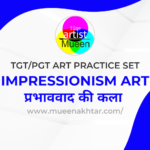
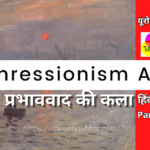

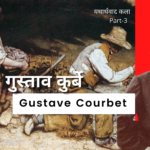
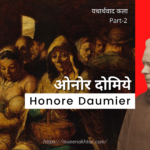
Bahut sunder prastuti hai sir ji 🙏
Thank you so much mam.
Pingback: Folk Art | What is Folk Art (लोक कला)? | Mueen Akhtar
Pingback: Warli Human Figures | Warli Painting Tutorial Lesson 1 | Mueen Akhtar